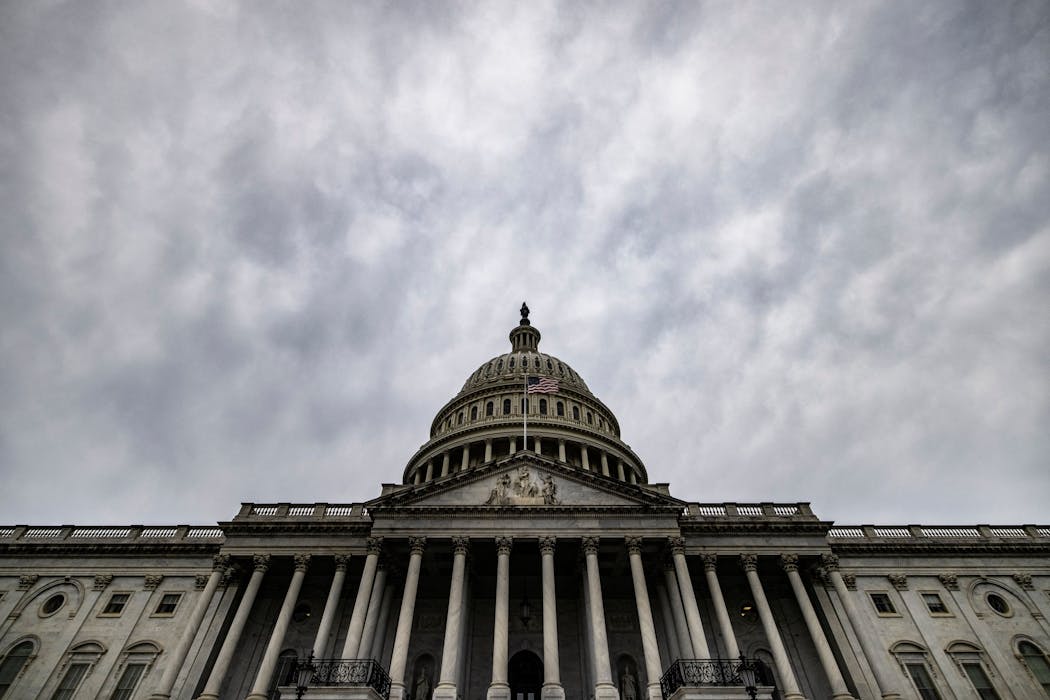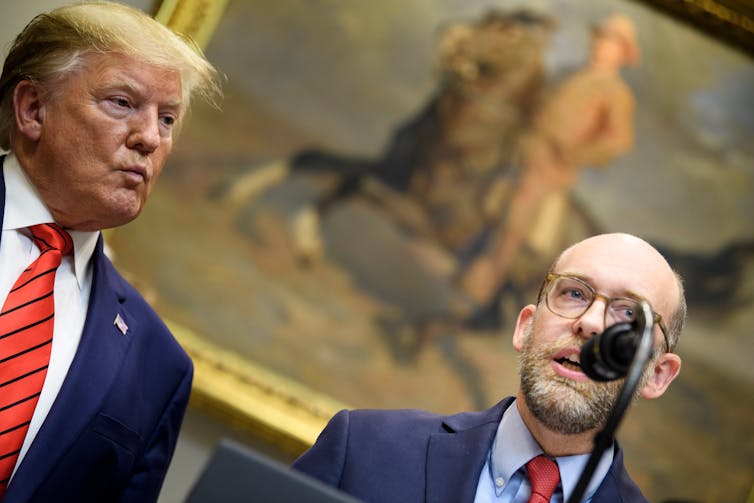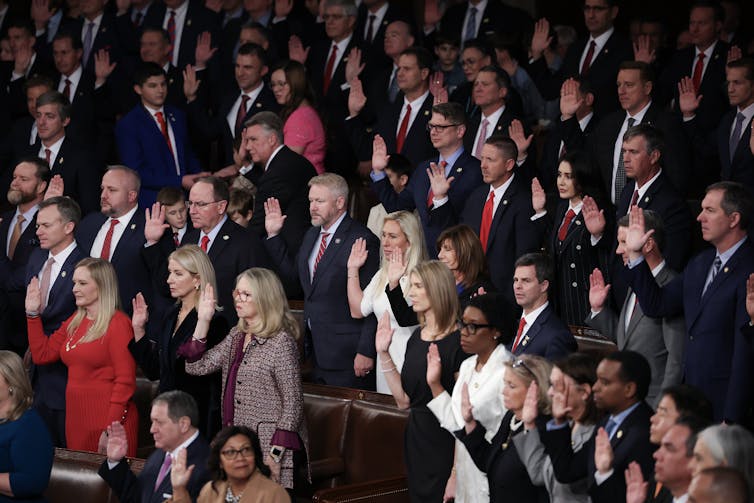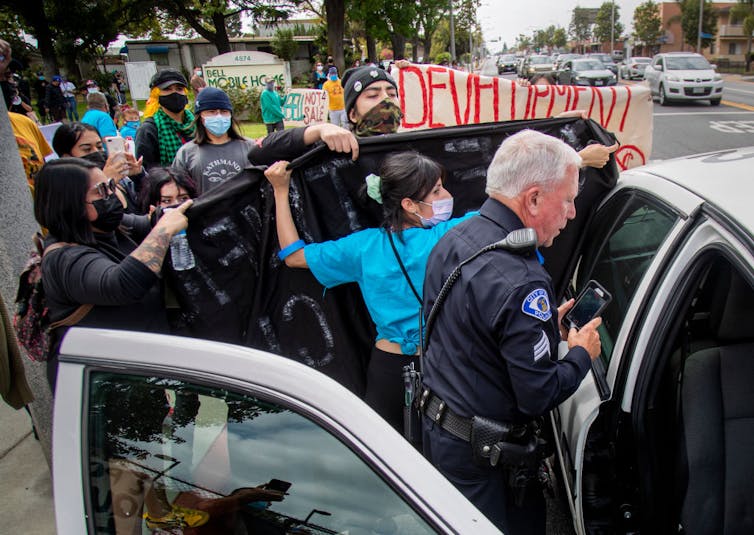Source: The Conversation – in French – By Jean-Philippe Melchior, Professeur des universités en sociologie, Le Mans Université
La combinaison de son recul économique, de la dégradation du contexte international et du possible désengagement de Washington du Vieux Continent place l’UE devant une alternative : continuer à n’être qu’une plateforme commerciale et normative, sachant que les recettes néolibérales appliquées au cours des dernières décennies ont mécontenté de larges pans de la population, ou aller plus avant vers une intégration politique plus poussée.
Quand tout s’accélère sur le plan géopolitique, il est essentiel de relier les événements aux tendances structurelles qui les nourrissent. Depuis février 2025, l’inquiétude grandit en Europe : le président des États-Unis, qui affirmait pouvoir mettre fin au conflit russo-ukrainien « en un jour », se soucie peu de la souveraineté de Kiev. L’échange tendu du 28 février entre Donald Trump et Volodymyr Zelensky, de même que la rencontre à tonalité très amicale d’Anchorage avec Vladimir Poutine le 16 août ont montré que Washington pousse à un cessez-le-feu à n’importe quelle condition, quitte à sacrifier les intérêts de l’Ukraine.
Cette posture met en évidence la dépendance persistante de l’Union européenne à l’égard des États-Unis et oblige à repenser ses fondements. Après un rappel des fragilités de la construction européenne, il convient d’identifier les défis suscités par la politique américaine, puis de réfléchir aux opportunités qu’offre cette nouvelle configuration.
Le rôle d’accélérateur de l’UE dans la généralisation des politiques néolibérales
Le compromis social forgé après 1945 – droits sociaux, services publics, redistribution, sécurité de l’emploi – s’est progressivement érodé, laissant place à un capitalisme dérégulé. Le rôle joué par l’UE dans cette mutation, amorcée dès les années 1980, est souvent sous-estimé.
Dans un contexte de mondialisation, les élites économiques ont cherché à doter l’Europe d’un vaste marché intégré. Droite, centre et social-démocratie ont relayé cet objectif, conçu comme un moyen de rivaliser avec les États-Unis et le Japon. L’Acte unique (1986) et les traités de Maastricht (1992) et d’Amsterdam (1997) ont accéléré les transferts de compétences et favorisé une déréglementation sans précédent. Parallèlement, l’élargissement vers l’Europe centrale et orientale a accentué cette dynamique, permettant aux grandes entreprises d’opérer à l’échelle continentale.
Ces choix ont engendré, dans la quasi-totalité des pays de l’UE, des renoncements majeurs : perte de souveraineté budgétaire, affaiblissement de la protection sociale, recul des services publics, flexibilité accrue du travail.
L’orientation néolibérale de l’UE a nourri la défiance des catégories populaires et contribué à la montée de l’extrême droite. Sans rupture avec cette trajectoire, l’UE risque de perdre encore en légitimité et de voir croître les forces hostiles à l’intégration.
Pourtant, l’UE a acquis des compétences étatiques importantes – légiférer, négocier des accords commerciaux, développer une banque centrale. Elle s’est affirmée comme un proto-État, mais dont la vocation demeure largement économique. L’UE n’a pas encore trouvé le chemin d’un équilibre entre intégration économique et justice sociale, ce qui alimente sa vulnérabilité politique.
Un contexte international difficile pour l’UE
L’Europe reste une zone développée mais affiche une croissance atone : 1 à 1,5 % prévus dans la décennie, contre 3 % aux États-Unis et des niveaux supérieurs pour la Chine et l’Inde.
Cette perte de vitesse économique intervient à un moment où la guerre est aux portes de l’UE (rappelons que l’Ukraine est frontalière de trois pays membres : la Pologne, la Slovaquie et la Roumanie).
L’Europe a tardé à percevoir la nature agressive du régime russe. Géorgie en 2008, Crimée en 2014, Donbass ensuite : autant de signaux d’un impérialisme assumé que l’Union a eu tendance à minorer. L’invasion à grande échelle de l’Ukraine en 2022 a contraint l’UE à réagir, non sans retard, et non sans divergences internes notables, dont la posture de Viktor Orban est la manifestation la plus éclatante. À ce stade, la mobilisation ukrainienne et l’aide militaire occidentale ont permis de contenir l’armée russe, mais environ 20 % du territoire restent occupés.
Le retour de Donald Trump à la Maison Blanche en janvier 2025 a bouleversé les équilibres : relèvement brutal des droits de douane, retrait d’accords multilatéraux (OMS, accords de Paris sur le climat), discours isolationniste et pressions sur l’Ukraine pour que celle-ci accepte de céder ses territoires. L’idée même d’une alliance atlantique « éternelle » est remise en cause, d’autant que l’UE a été contrainte d’accepter un accord commercial aux conditions très favorables aux États-Unis.
Cette rupture force l’Europe à réfléchir à son autonomie stratégique.
Faute de moyens militaires suffisants, elle pourrait promouvoir un compromis imposant la neutralité de l’Ukraine en échange d’un retrait russe partiel. Mais un tel scénario fragiliserait durablement Kiev et renforcerait l’insécurité des pays frontaliers, exposés à une éventuelle attaque russe sans disposer de défense commune solide. Dans le même temps, le retrait de Washington des institutions multilatérales, ses ambitions territoriales inédites et son désintérêt pour le climat accentuent la nécessité d’un repositionnement global de l’UE. La pression exercée par les États-Unis pour que l’Europe assume seule ses responsabilités militaires place les gouvernements face à des choix budgétaires et diplomatiques de long terme.
Une redéfinition nécessaire, mais peu probable à court et moyen termes
L’UE se trouve à un tournant décisif : soit elle reste un grand marché régulé par la concurrence, soit elle se transforme en puissance politique. Trois paramètres seront déterminants.
Les dynamiques politiques internes. En France, la dissolution de 2024 a plongé le pays dans une instabilité durable. Le gouvernement, privé de majorité, peine à assumer un rôle moteur en Europe, et se concentre sur un discours militaire ponctuel. En Allemagne, la victoire relative de la CDU en 2025 a permis l’émergence d’un chancelier pro-européen, Friedrich Merz, malgré la poussée de l’AFD. La solidité institutionnelle allemande offre à Berlin la possibilité de relancer le projet européen, au moment où Paris se fragilise. Mais là encore, la marge de manœuvre dépendra de la capacité du nouveau gouvernement à construire des alliances solides et à répondre aux défis sociaux et économiques qui fragilisent sa légitimité interne.
Les divergences entre États membres. Les pays d’Europe centrale et septentrionale (Pologne, États baltes, Suède, Finlande) militent pour une intégration sécuritaire renforcée. Mais la Hongrie d’Orban et l’Italie de Meloni bloquent toute évolution fédérale. L’absence de consensus entrave la capacité de l’UE à peser dans la reconfiguration mondiale, que ce soit en Ukraine ou au Moyen-Orient. Si le pacte Trump-Poutine venait à se fissurer, les membres de l’UE sauraient-ils dépasser leurs réflexes pro-américains ou pro-russes pour tracer, ensemble, une voie autonome ? La réponse demeure incertaine. La tentation, pour certains États, de privilégier des accords bilatéraux avec Washington ou Moscou persistera tant que l’UE n’aura pas affirmé un cap commun.
Le rôle des peuples. Toute avancée vers un État fédéral ou confédéral suppose l’adhésion populaire. Or la légitimité de l’UE est entamée par des décennies de politiques néolibérales. Pour restaurer la confiance, il faudrait instaurer un véritable pouvoir constituant, renforcer le Parlement européen, multiplier les débats démocratiques transnationaux et rompre avec une logique purement économique. C’est une condition nécessaire pour qu’une défense commune et des compétences régaliennes soient acceptées. À défaut, l’UE risque de rester une construction technocratique perçue comme distante des préoccupations quotidiennes. Le défi est de transformer l’intégration européenne en projet mobilisateur, porteur de justice sociale, de transition écologique et de sécurité collective.
Un choix stratégique
En définitive, l’Union européenne se trouve face à un choix stratégique : demeurer un simple marché soumis aux rapports de force mondiaux, ou se transformer en puissance politique capable de défendre ses intérêts et ses valeurs. Une telle transformation suppose de surmonter ses fragilités internes, de marginaliser les forces nationalistes hostiles à toute intégration, et surtout d’associer les peuples à une véritable refondation.
À ces conditions, l’UE pourrait enfin s’imposer comme acteur autonome et redonner un sens au projet européen. Sans cette évolution, elle restera spectatrice des recompositions géopolitiques dominées par Washington et Moscou.
![]()
Jean-Philippe Melchior ne travaille pas, ne conseille pas, ne possède pas de parts, ne reçoit pas de fonds d’une organisation qui pourrait tirer profit de cet article, et n’a déclaré aucune autre affiliation que son organisme de recherche.
– ref. L’Union européenne à la croisée des chemins – https://theconversation.com/lunion-europeenne-a-la-croisee-des-chemins-267686


























